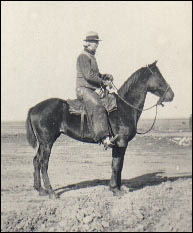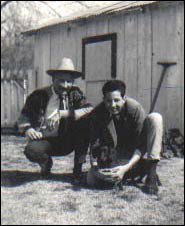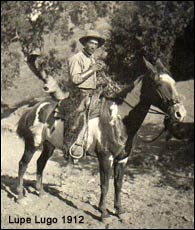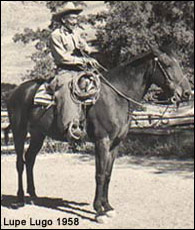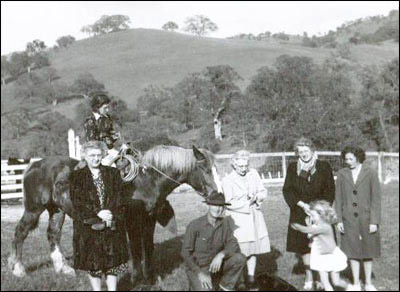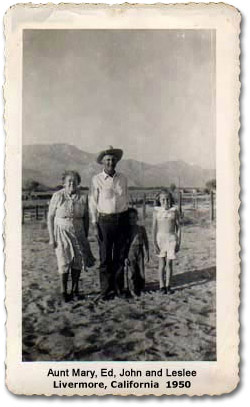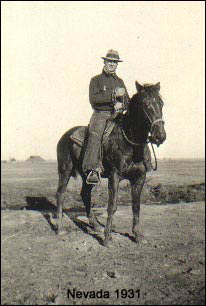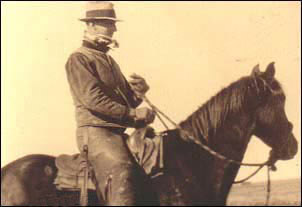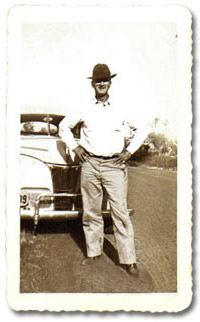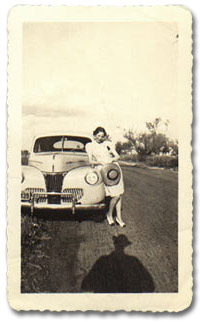
I can recall him typing by candlelight on an old typewriter. It was finally completed in October, 1948. It took almost three years to find a publisher for HACKAMORE REINSMAN…no one wanted to take a chance on it, as nothing like it had ever been published before. Jim Draper, publisher of Horse Lover's Magazine, arranged for well known Western Artist, Randy Steffen, to meet my father. At the time we were living in San Miguel, California, just outside Paso Robles. Randy sat on the fence with sketch pad in hand while my father put his horse through it's paces and different maneuvers. It was finally published in Cisco, Texas in the spring of 1952. Arrangements for publication were made by Randy Steffen. REINSMAN OF THE WEST was written while I was in high school in the mid to late 50's and was published in March, 1964. It was amazing to all of us that he never had a draft whereby he could make insertions or corrections. All his knowledge was entirely in his head, and he typed everything down one time only, step by step. Rarely did he ever have to go back to add or change anything, and he had become quite adept at typing with his index fingers.I have been told numerous times that when Ed wrote HACKAMORE REINSMAN, he made the assumption that the rider was considerably experienced and already had more than a basic understanding and knowledge of horsemanship. This is true. Those with less experience may find these books advanced…they should be with someone who understands these methods.
He has stated in his books and articles that his books are for the amateur as well as the professional. It is my personal opinion that the interpretation of the definition of amateur has changed over the years. In those days the amateur had some experience and knowledge behind him. Today the amateur for the most part is a rank beginner who is in the throes of learning everything from the very beginning. These books are not for them…yet. But they can be in the future with practice, dedication and understanding. They are MANUALS OF INSTRUCTION only. HACKAMORE REINSMAN must be read, re-read, and studied very carefully. Dad wrote in a style that is conducive to understanding…he wrote as though he was talking to you personally. His English wasn't perfect, but that is the way he spoke. In 1995, I republished HACKAMORE REINSMAN, because the original publisher retired. It is the first half of the training process and REINSMAN OF THE WEST - BRIDLES & BITS is the second half. It was imperative that the hackamore book be kept on the market. Without it, REINSMAN OF THE WEST would be difficult to comprehend and understand. There had been some missing sentences and printing errors in the hackamore book, and it needed to be corrected and made more presentable. It is the same book. When I spoke to some of Ed's friends and a few cowboys, they all said that they hoped I would never change his writing. The fact is I couldn't, as I would not have known nor understood how. "We cowboys understand what he was sayin", they explained. All I could do was reassure them that nothing would be changed….and smile. These methods were used in Europe with the dressage horses many hundreds of years ago and can be applied to other forms of horsemanship as well. Their roots are in dressage. The horses were highly trained for fighting the many wars that occurred. This training descended from the Moors (actually pre-Moor) who in turn taught the Spanish Conquistadors. They in turn brought this training to the New World, developing the hair-trigger reined or whisper-reined horses found in California. Ed's method is pure "Californio", and he considered himself fortunate to have lived in one of the most colorful periods in the history of California.
What Ed knew was an ART FORM and TRADITION…a HERITAGE passed on from father to son to friend. These were the OLD WAYS…THESE ARE THE OLD WAYS AND THEY HAVE NEVER BEEN IMPROVED UPON. There has never been a short cut to perfection. THIS IS A WAY OF LIFE THAT SHOULD AND MUST BE PRESERVED FOREVER. By publishing this book, I'm trying to do my small part in keeping this work alive. This was his legacy left to every horseman. The last of the greatest horsemen of that era in the Western Hemisphere lived from the 1900's to the 1930's. He was in this group. They were all older, and they were not teaching others. They preferred to keep their training secrets to themselves, but sometimes would reveal information if they liked you. There were literally only a handful of men in the United States in the 1950's who could do what Ed could do, and they were all older than he. And none of them could or would explain a thing. He was the youngest one. Time and time again I heard him say that he was the end of the line. Ed was very lucky to have had a few of the Vaqueros take him under their wing, and it was obvious that he had a burning desire to learn. Very few opened up to him, and some things he had to figure out for himself…and that, he did. He followed the Vaqueros around so that he could learn from them, especially Luis Lupe Lugo, who became his life long friend. Jack Rose, Tom Holly, Quill Downey and Tude Wilson were also instrumental in his accumulation of knowledge. HE HELD TRUE TO THE TRADITIONS OF THE ERA FROM WHENCE HE CAME.
There were many top men of varying degrees, and not all top men could do what the Master Horseman could do. Only one out of ten would be a Vaquero, the Master Horseman, and that's what he was. He could do it all, and he was especially known for his headset. The horses they made were incomparable, and the horse spoke for the man by how well he worked. I've had several people tell me that Dad was the last link to the "Days of the Dons", this makes sense to me. He was. I have asked my daughter to create a definition of mastery, which she has adopted in her work as an actress. It is my hope to empower everyone who wishes to strive for perfection to use this philosophy…or at the very least, incorporate it in their work. This explanation can be applied to any craft; it most certainly applies to Ed Connell.
Ed wrote his books not with the idea of making a name for himself but to PRESERVE what he knew in writing. He was shocked and flabbergasted when his books began selling all over the world; in fact, the response and respect he received was sometimes overwhelming. Even today, I receive phone calls and letters from people who have used his books exclusively referring to him as a legend or icon, telling me they would have given the world to have met and studied with him. They have told me how successful they were in training their horses, sometimes not understanding a particular point until five or ten years down the road. This is not unusual. What many people may not realize is that this training can be applied to any kind of horsemanship. HACKAMORE REINSMAN has been referred to as the BIBLE for years by everyone who used and understood it. This is a book that has to be dissected and studied very carefully. The same is true of REINSMAN OF THE WEST. One will learn if not consumed by blind prejudice. Both of these books are considered classics, are still in demand and have been on the market since 1952 and 1964, respectively. The fact that HACKAMORE REINSMAN has lasted for 72 years is a testament to the knowledge, talent, ability and sincerity of Ed Connell. This in itself says everything about Ed's work, the value of both books and the respect he garnered worldwide.
Very little has been written about my father's background. He was born in Livermore, California, July 28, 1900 and was the youngest of five children born to William John and Alice Cass Connell. His father had four Professorships (mathematics, civil engineering, economics and law). He was an educator, principal and superintendent of schools in Visalia, Livermore and Berkeley. Later he taught at the Polytechnic College of Engineering in Oakland. His mother was a professor of English and a journalist. She wrote for various magazines. Ed had three sisters…one was a bacteriologist, the second a counselor and teacher and the third worked for the military in San Francisco. He had a brother, who died in infancy. He came from a family of overachievers and education was a must in his home. My father, being a free spirit, rebelled, much to the consternation of his father. For years, he became the black sheep of the family. Ed was a man who adored his mother and respected his father, although he was not close to his father, as he was a stern and distant man. However, he did buy Ed a pony when he was six years of age which was instrumental in lighting the spark that made him want to master all he could. The horse bug stayed with him from that point on. As he was growing up in Livermore, he had access to horses from his family's cook, Mary Dennihan. "Aunt Mary" as she had come to be called by John and me, had become a second mother to my father. While his family lived in Berkeley, he lived with Mary and Mike Dennihan in Livermore, California.
Dad used to watch the Vaqueros play cards at Corral Hollow, and he was occasionally invited to join them in their games. Ed studied their horsemanship every chance he could. He refused to go to college and left home at the age of 17. By then he was already an accomplished rider. His education and learning was about to begin. By that time, he had met Lupe Lugo and Tom Holly who had taken him under their wing. He began training horses for the Moy and Jackson ranches. He worked hard and followed the Master Horsemen (also known as the Vaqueros) as he wanted to learn from the best.
About 1929 - 1930, during the Depression, he began training polo ponies for Charlie Howard, who owned the famous race horse Seabiscuit. Ed worked the great Hearst Ranch on the King City side and became cowboy boss of the Miller and Lux Bloomfield Ranch. He cowboyed and broke horses for most of the cattle ranches in the Mount Hamilton District; the Gerber Ranch, Hubbards, Morrows, Orestimba, Oak Flat, The Canada out of Gilroy and the Ordway Ranch.
During the Depression, he supported himself by entering the rodeos and playing poker with the Hetch Hetchy miners and cowboys in Livermore. He was a good poker player too. Ed's father convinced him to go back to school, at which time he took a two year non-degree course in animal husbandry from the University of California at Davis. One month before completing the course, he and his friend walked out of their class in absolute disgust. It seemed the Professor teaching this class had hardly been around cattle or in the field and they knew he was wrong about the subject matter. Ed went right back to working the ranches in California, Oregon and Nevada for several years. Ed was fast becoming an accomplished horseman. He worked for D. M. McLemore in Livermore as head shipper of one of the largest cattle outfits in the west; he classified them and sent them out by railroad to headquarters in Barstow. My father was a Brand Inspector for the State of California in the late 30's when he met my mother, Irene Thornley, in Newman, California. She was born and raised in Pincher Creek, Alberta and Sidney, B. C., Canada. His promise to himself to remain a bachelor for life completely changed when he met her. They were married in August, 1941.
|
||||||||||||||||||||||||||||||||||||||||||
 |
|
Copyright © 1999 - 2024 - Ed Connell
- Official Website - All Rights Reserved
|

